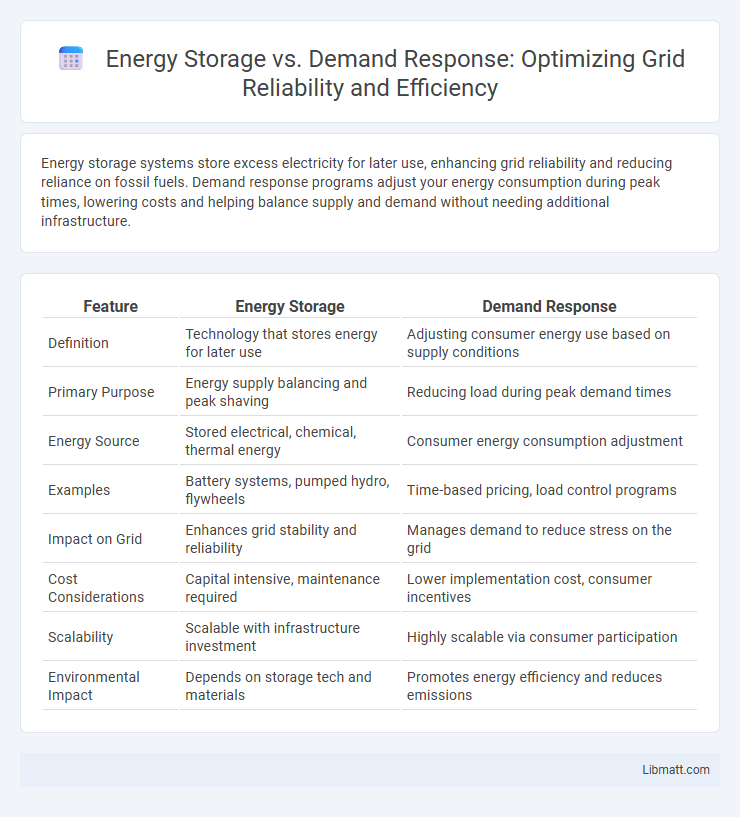Energy storage systems store excess electricity for later use, enhancing grid reliability and reducing reliance on fossil fuels. Demand response programs adjust your energy consumption during peak times, lowering costs and helping balance supply and demand without needing additional infrastructure.
Table of Comparison
| Feature | Energy Storage | Demand Response |
|---|---|---|
| Definition | Technology that stores energy for later use | Adjusting consumer energy use based on supply conditions |
| Primary Purpose | Energy supply balancing and peak shaving | Reducing load during peak demand times |
| Energy Source | Stored electrical, chemical, thermal energy | Consumer energy consumption adjustment |
| Examples | Battery systems, pumped hydro, flywheels | Time-based pricing, load control programs |
| Impact on Grid | Enhances grid stability and reliability | Manages demand to reduce stress on the grid |
| Cost Considerations | Capital intensive, maintenance required | Lower implementation cost, consumer incentives |
| Scalability | Scalable with infrastructure investment | Highly scalable via consumer participation |
| Environmental Impact | Depends on storage tech and materials | Promotes energy efficiency and reduces emissions |
Introduction to Energy Storage and Demand Response
Energy storage systems store excess energy generated during low-demand periods to be used later, enhancing grid reliability and efficiency. Demand response involves adjusting consumer energy usage in response to supply conditions, helping balance load without additional energy production. Understanding both strategies can help you optimize energy management and reduce costs while supporting a stable power grid.
Key Concepts: Defining Energy Storage and Demand Response
Energy storage involves capturing energy produced at one time for use at a later time, improving grid stability and balancing supply with demand through technologies like batteries and pumped hydro. Demand response entails adjusting consumer electricity usage patterns during peak periods to reduce strain on the grid, often incentivized by time-based rates or direct load control. Both strategies enhance grid efficiency, but energy storage physically holds energy while demand response manages consumption behavior.
How Energy Storage Works in Modern Grids
Energy storage systems in modern grids capture excess electricity generated from renewable sources or off-peak production, storing it in batteries, thermal units, or pumped hydro facilities for later use. These systems enhance grid stability by releasing stored energy during peak demand periods, reducing reliance on fossil fuel-based peaker plants. Advanced energy storage technologies integrate with smart grid management and real-time data analytics to optimize load balancing and support grid resilience.
Demand Response: Mechanisms and Applications
Demand response mechanisms involve adjusting consumer electricity usage patterns in response to supply conditions, price signals, or grid reliability needs, effectively reducing peak demand and balancing grid load. Applications include time-based pricing, direct load control, and incentive programs that encourage consumers to shift or curtail energy consumption during high demand periods. This approach enhances grid flexibility, reduces reliance on fossil-fuel-powered peaker plants, and supports the integration of renewable energy sources.
Comparing Benefits: Flexibility, Reliability, and Cost
Energy storage systems provide high flexibility by storing excess energy for later use, enhancing grid reliability during peak demand or outages. Demand response programs improve reliability by adjusting consumer usage patterns, reducing strain on the grid without requiring physical energy reserves. While energy storage typically involves higher upfront costs with long-term operational savings, demand response offers cost-effective, immediate load management with lower capital investment.
Limitations and Challenges of Energy Storage
Energy storage faces limitations such as high upfront costs, limited energy capacity, and degradation over time, which reduce system lifespan and efficiency. Thermal, chemical, and mechanical storage technologies require ongoing maintenance and can encounter safety risks, particularly with lithium-ion batteries. Your ability to balance grid reliability may be hindered by the intermittent nature of stored energy and regulatory constraints on deployment scale.
Barriers to Effective Demand Response Implementation
Barriers to effective demand response implementation include limited consumer engagement, lack of advanced metering infrastructure, and regulatory constraints that hinder real-time communication and pricing signals. Energy storage systems provide a more predictable and controllable solution to grid flexibility but require high upfront investments and technological integration. Your ability to optimize energy use depends on overcoming these challenges through technological innovation and policy support.
Role in Renewable Energy Integration
Energy storage systems play a crucial role in renewable energy integration by storing excess energy generated from solar and wind sources, ensuring a stable supply during periods of low generation. Demand response strategies complement this by adjusting consumer energy usage in real-time to match renewable output fluctuations, reducing the need for fossil fuel backups. Together, energy storage and demand response enhance grid flexibility, reliability, and enable higher penetration of renewable energy sources.
Economic and Environmental Impacts
Energy storage systems reduce reliance on fossil fuels by storing excess renewable energy, leading to lower carbon emissions and providing economic benefits through grid stabilization and peak load shaving. Demand response programs cut operational costs by shifting or reducing energy usage during peak hours, decreasing the need for expensive infrastructure investments and reducing greenhouse gas emissions. Combining both strategies can optimize energy efficiency, enhance grid resilience, and result in significant economic savings alongside improved environmental sustainability.
Future Outlook: Synergies and Market Trends
Energy storage and demand response are converging to create more resilient and flexible energy systems by integrating battery technologies with real-time consumption adjustments, unlocking significant grid optimization potential. Market trends indicate accelerated investment in hybrid solutions, leveraging the rapid decline in lithium-ion battery costs alongside advanced demand response platforms driven by AI and IoT. You can expect these synergies to enhance grid stability, lower overall energy costs, and accelerate the transition to renewable energy sources in the near future.
Energy Storage vs Demand Response Infographic

 libmatt.com
libmatt.com